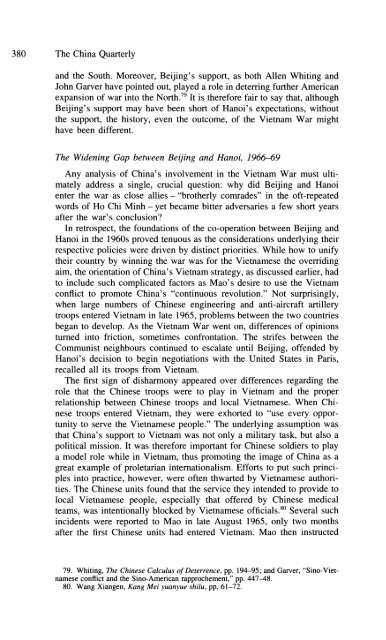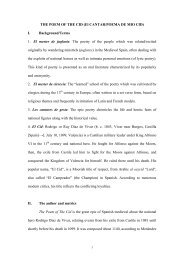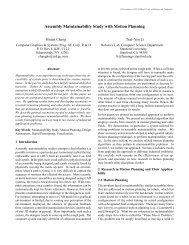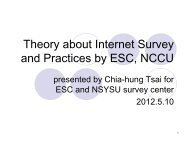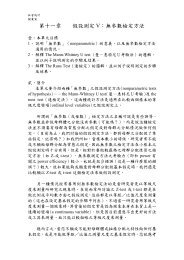380 The Ch<strong>in</strong>a Quarterlyand <strong>the</strong> South. Moreover, Beij<strong>in</strong>g's support, as both Allen Whit<strong>in</strong>g andJohn Garver have po<strong>in</strong>ted out, played a role <strong>in</strong> deterr<strong>in</strong>g fur<strong>the</strong>r Americanexpansion of war <strong>in</strong>to <strong>the</strong> North.79 It is <strong>the</strong>refore fair to say that, althoughBeij<strong>in</strong>g's support may have been short of Hanoi's expectations, without<strong>the</strong> support, <strong>the</strong> history, even <strong>the</strong> outcome, of <strong>the</strong> <strong>Vietnam</strong> <strong>War</strong> mighthave been different.The Widen<strong>in</strong>g Gap between Beij<strong>in</strong>g and Hanoi, 1966-69Any analysis of <strong>Ch<strong>in</strong>a's</strong> <strong>in</strong>volvement <strong>in</strong> <strong>the</strong> <strong>Vietnam</strong> <strong>War</strong> must ultimatelyaddress a s<strong>in</strong>gle, crucial question: why did Beij<strong>in</strong>g and Hanoienter <strong>the</strong> war as close allies - "bro<strong>the</strong>rly comrades" <strong>in</strong> <strong>the</strong> oft-repeatedwords of Ho Chi M<strong>in</strong>h - yet became bitter adversaries a few short yearsafter <strong>the</strong> war's conclusion?In retrospect, <strong>the</strong> foundations of <strong>the</strong> co-operation between Beij<strong>in</strong>g andHanoi <strong>in</strong> <strong>the</strong> 1960s proved tenuous as <strong>the</strong> considerations underly<strong>in</strong>g <strong>the</strong>irrespective policies were driven by dist<strong>in</strong>ct priorities. While how to unify<strong>the</strong>ir country by w<strong>in</strong>n<strong>in</strong>g <strong>the</strong> war was for <strong>the</strong> <strong>Vietnam</strong>ese <strong>the</strong> overrid<strong>in</strong>gaim, <strong>the</strong> orientation of <strong>Ch<strong>in</strong>a's</strong> <strong>Vietnam</strong> strategy, as discussed earlier, hadto <strong>in</strong>clude such complicated factors as Mao's desire to use <strong>the</strong> <strong>Vietnam</strong>conflict to promote <strong>Ch<strong>in</strong>a's</strong> "cont<strong>in</strong>uous revolution." Not surpris<strong>in</strong>gly,when large numbers of Ch<strong>in</strong>ese eng<strong>in</strong>eer<strong>in</strong>g and anti-aircraft artillerytroops entered <strong>Vietnam</strong> <strong>in</strong> late 1965, problems between <strong>the</strong> two countriesbegan to develop. As <strong>the</strong> <strong>Vietnam</strong> <strong>War</strong> went on, differences of op<strong>in</strong>ionsturned <strong>in</strong>to friction, sometimes confrontation. The strifes between <strong>the</strong>Communist neighbours cont<strong>in</strong>ued to escalate until Beij<strong>in</strong>g, offended byHanoi's decision to beg<strong>in</strong> negotiations with <strong>the</strong> United States <strong>in</strong> Paris,recalled all its troops from <strong>Vietnam</strong>.The first sign of disharmony appeared over differences regard<strong>in</strong>g <strong>the</strong>role that <strong>the</strong> Ch<strong>in</strong>ese troops were to play <strong>in</strong> <strong>Vietnam</strong> and <strong>the</strong> properrelationship between Ch<strong>in</strong>ese troops and local <strong>Vietnam</strong>ese. When Ch<strong>in</strong>esetroops entered <strong>Vietnam</strong>, <strong>the</strong>y were exhorted to "use every opportunityto serve <strong>the</strong> <strong>Vietnam</strong>ese people." The underly<strong>in</strong>g assumption wasthat <strong>Ch<strong>in</strong>a's</strong> support to <strong>Vietnam</strong> was not only a military task, but also apolitical mission. It was <strong>the</strong>refore important for Ch<strong>in</strong>ese soldiers to playa model role while <strong>in</strong> <strong>Vietnam</strong>, thus promot<strong>in</strong>g <strong>the</strong> image of Ch<strong>in</strong>a as agreat example of proletarian <strong>in</strong>ternationalism. Efforts to put such pr<strong>in</strong>ciples<strong>in</strong>to practice, however, were often thwarted by <strong>Vietnam</strong>ese authorities.The Ch<strong>in</strong>ese units found that <strong>the</strong> service <strong>the</strong>y <strong>in</strong>tended to provide tolocal <strong>Vietnam</strong>ese people, especially that offered by Ch<strong>in</strong>ese medicalteams, was <strong>in</strong>tentionally blocked by <strong>Vietnam</strong>ese officials.80 Several such<strong>in</strong>cidents were reported to Mao <strong>in</strong> late August 1965, only two monthsafter <strong>the</strong> first Ch<strong>in</strong>ese units had entered <strong>Vietnam</strong>. Mao <strong>the</strong>n <strong>in</strong>structed79. Whit<strong>in</strong>g, The Ch<strong>in</strong>ese Calculus of Deterrence, pp. 194-95; and Garver, "S<strong>in</strong>o-<strong>Vietnam</strong>eseconflict and <strong>the</strong> S<strong>in</strong>o-American rapprochement," pp. 447-48.80. Wang Xiangen, Kang Mei yuanyue shilu, pp. 61-72.
Ch<strong>in</strong>a <strong>in</strong> <strong>the</strong> <strong>Vietnam</strong> <strong>War</strong>, <strong>1964</strong>-69 381Ch<strong>in</strong>ese troops <strong>in</strong> <strong>Vietnam</strong> "not to be too enthusiastic [<strong>in</strong> offer<strong>in</strong>g serviceto <strong>the</strong> <strong>Vietnam</strong>ese]."8"As it turns out, however, such precaution did little to improve <strong>the</strong>situation. The feel<strong>in</strong>g of solidarity between Beij<strong>in</strong>g and Hanoi wanedquickly. This subtle change <strong>in</strong> attitude is illustrated by <strong>the</strong> personalexperiences of <strong>the</strong> command<strong>in</strong>g officers of <strong>the</strong> CPVEF's second division.In June 1965, when <strong>the</strong> division entered <strong>Vietnam</strong>, <strong>the</strong> command<strong>in</strong>gofficers were <strong>in</strong>vited to Hanoi, where <strong>the</strong>y were warmly received by HoChi M<strong>in</strong>h, Pham Van Dong and Vo Nguyen Giap. But when <strong>the</strong> divisionf<strong>in</strong>ally left <strong>Vietnam</strong> <strong>in</strong> October 1966, <strong>the</strong> division representatives found <strong>in</strong>Hanoi that <strong>the</strong> atmosphere had cooled significantly. They felt that"someth<strong>in</strong>g was wrong <strong>in</strong> <strong>the</strong> Ch<strong>in</strong>ese-<strong>Vietnam</strong>ese relationship.'"82The deteriorat<strong>in</strong>g relationship between Beij<strong>in</strong>g and Moscow, toge<strong>the</strong>rwith <strong>the</strong> beg<strong>in</strong>n<strong>in</strong>g of <strong>the</strong> Cultural Revolution <strong>in</strong> Ch<strong>in</strong>a, fur<strong>the</strong>r triggeredtension and conflict between Beij<strong>in</strong>g and Hanoi. Until <strong>the</strong> mid-1960s,Beij<strong>in</strong>g assumed that <strong>the</strong> <strong>Vietnam</strong>ese Workers' Party was on <strong>Ch<strong>in</strong>a's</strong> side<strong>in</strong> <strong>the</strong> struggle aga<strong>in</strong>st <strong>the</strong> "Soviet revisionism."83 But ties between Hanoiand Moscow <strong>in</strong>creased as <strong>the</strong> <strong>Vietnam</strong> <strong>War</strong> progressed. After Khrushchevwas ousted by his colleagues <strong>in</strong> October <strong>1964</strong>, Moscow began to provideHanoi with substantial support while at <strong>the</strong> same time call<strong>in</strong>g on socialistcountries to adopt a unified stand <strong>in</strong> support<strong>in</strong>g <strong>Vietnam</strong>.84 On 11February 1965, <strong>the</strong> Soviet Prime M<strong>in</strong>ister A.N. Kosyg<strong>in</strong> stopped <strong>in</strong>Beij<strong>in</strong>g on his way back from <strong>Vietnam</strong> to meet Mao Zedong and ZhouEnlai. He suggested that Ch<strong>in</strong>a and <strong>the</strong> Soviet Union should stop <strong>the</strong>polemic between <strong>the</strong>m, so that <strong>the</strong>y could take jo<strong>in</strong>t steps to support <strong>the</strong>struggle of <strong>the</strong> <strong>Vietnam</strong>ese people. Mao refused Kosyg<strong>in</strong>'s suggestion,claim<strong>in</strong>g that his debates with <strong>the</strong> Soviets would last for ano<strong>the</strong>r 9,000years.85 Hanoi had s<strong>in</strong>ce become silent <strong>in</strong> its criticism of "revisionism."Mao's l<strong>in</strong>k<strong>in</strong>g of <strong>the</strong> polemic aga<strong>in</strong>st Moscow to <strong>the</strong> <strong>in</strong>ner-Partystruggle <strong>in</strong> Ch<strong>in</strong>a fur<strong>the</strong>r complicated <strong>the</strong> situation. In February andMarch 1966, a high-rank<strong>in</strong>g Japanese Communist Party delegationheaded by Miyamoto Kenji, <strong>the</strong> JCP's General Secretary, visited Ch<strong>in</strong>aand North <strong>Vietnam</strong>, attempt<strong>in</strong>g to promote an "anti-imperialist <strong>in</strong>ternationalunited front" <strong>in</strong>clud<strong>in</strong>g both Ch<strong>in</strong>a and <strong>the</strong> Soviet Union. Learn<strong>in</strong>gthat Hanoi had demonstrated great <strong>in</strong>terest <strong>in</strong> this idea, <strong>the</strong> Ch<strong>in</strong>eseParty delegation headed by Liu Shaoqi and Deng Xiaop<strong>in</strong>g managed towork out an agreement with Miyamoto, accord<strong>in</strong>g to which Ch<strong>in</strong>a wouldvirtually jo<strong>in</strong> this "<strong>in</strong>ternational united front." However, Mao <strong>in</strong>tervened81. Ibid. p. 74.82. Ibid. p. 255.83. For a discussion, see Smith, An International History of <strong>the</strong> <strong>Vietnam</strong> <strong>War</strong>, Vol. 2, ch.12 and Vol. 3, ch. 9; and K<strong>in</strong>g C. <strong>Chen</strong>, "North <strong>Vietnam</strong> <strong>in</strong> <strong>the</strong> S<strong>in</strong>o-Soviet dispute,1962-<strong>1964</strong>," Asian Survey, Vol. 4, No. 9 (September <strong>1964</strong>), pp. 1023-1036.84. Recent Russian scholarship confirms that after 1965, Soviet military and economicsupport to <strong>Vietnam</strong> <strong>in</strong>creased steadily and, as a result, <strong>the</strong> relationship between Hanoi andMoscow became much closer. See Ilya V. Gaiduk and Oganez V. Mar<strong>in</strong><strong>in</strong>, "The <strong>Vietnam</strong> <strong>War</strong>and Soviet-American relations," paper presented at <strong>in</strong>ternational conference on New Sourceson <strong>the</strong> Cold <strong>War</strong>, Moscow, January 1993, pp. 8-9, 12-13.85. For a more detailed description of Mao's conversation with Kosyg<strong>in</strong>, see Cong J<strong>in</strong>,Quzhe qianj<strong>in</strong> de sh<strong>in</strong>ian, pp. 607-608.
- Page 1 and 2: China's Involvement in the Vietnam
- Page 3 and 4: China in the Vietnam War, 1964-69 3
- Page 5 and 6: China in the Vietnam War, 1964-69 3
- Page 7 and 8: China in the Vietnam War, 1964-69 3
- Page 9 and 10: China in the Vietnam War, 1964-69 3
- Page 11 and 12: China in the Vietnam War, 1964-69 3
- Page 13 and 14: China in the Vietnam War, 1964-69 3
- Page 15 and 16: China in the Vietnam War, 1964-69 3
- Page 17 and 18: China in the Vietnam War, 1964-69 3
- Page 19 and 20: China in the Vietnam War, 1964-69 3
- Page 21 and 22: China in the Vietnam War, 1964-69 3
- Page 23 and 24: China in the Vietnam War, 1964-69 3
- Page 25: Table 1: China's Military Supply to
- Page 29 and 30: China in the Vietnam War, 1964-69 3
- Page 31 and 32: China in the Vietnam War, 1964-69 3
- Page 33: China in the Vietnam War, 1964-69 3


